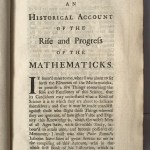EUCLID. The Elements of Euclid; With Select Theorems out of Archimedes…
London, Printed for W. Innys, T. Longman and T. Shewell…, and M. Senex…, 1747.
£300
8vo, pp. xiv (ii) 240 (iv) 68, A-U8 Z 4. Lacking frontispiece portrait. Title-page vignette of putti playing a trumpet and using a compass and a ruler while reading Euclid’s Elements, motto “hinc omnia”; 5 folding engraved plates of many figures. Archimedes’ Theorems have a separate dated title page and pagination, but the Register is continuous. Engraved vignette of a cone, cylinder and a sphere with motto “Una tribus Ratio est”. Large Cheshunt College Library bookplate on front fly with ink shelf mark and label of the Newport-Pagnel Evangelical Institution, book presented by “an anonymous friend”, on upper pastedown. In contemporary gilt-ruled calf, title on red morocco label to spine. Front joint to cover cracked but holding.
William Whiston (1667-1752) was an Anglican priest and mathematician who in 1703 succeeded Isaac Newton as Lucasian professor and, in the following year, he abridged and published the Elements of Euclid for the use of students at Cambridge. Whiston re-elaborated the work on Euclid of the Belgian Jesuit mathematician André Tacquet (1612-60), who wrote many good elementary texts designed as mathematics textbooks for Jesuit colleges. His Elementa geometriae (1654) was his most popular teaching work. This book was essentially constructed from Euclid’s Elements with material from Archimedes. It was a significant piece of work because of the clarity Tacquet demonstrated in presenting the material. Many editions of Elementa geometriae were produced over the next 100 years. For example, the present work appeared in a third edition published in London in 1727. Palladino writes about Tacquet’s Classes of measures: “The classical definitions of ratio and proportion, defined respectively by the third and the fifth definitions of Book V of Euclid’s Elements, were subjected to a rigorous examination in the seventeenth century: among the critics and revisers of those definitions [was] André Tacquet (whose definition of ‘equal reasons’ has inspired generations of mathematicians). … Tacquet devised refined procedures to figure out the ‘equality of reasons’ by approximation.” F. Palladino, On the theory of proportions in the seventeenth century. Two noteworthy contributions: ‘Cuts of rational numbers’ by the Galilean G. A. Borelli and ’Classes of measures’ by the Jesuit A. Tacquet (Italian), Nuncius Ann. Storia Sci. 6 (2) (1991), 33-81.










